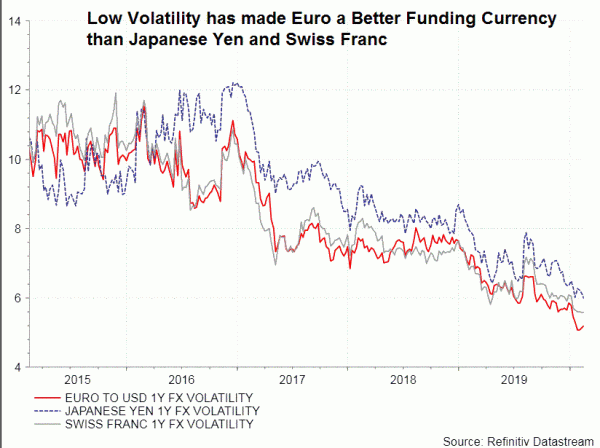Currently trading at 1.083 against USD, lowest since April 2017, the single currency has plunged -2.4% in the first half of February. This follows a -1% decline in January. Disappointing economic data, renewed speculations on further rate cut by ECB and intensified global uncertainty as driven by coronavirus outbreak originated in China are key reasons for euro’s selloff. Meanwhile, low yield and low volatility has made euro a popular funding currency, exacerbating its selloff at times of risk aversion.
Domestic economic developments: Economic indicators released since beginning of the months have been disappointing. Retail sales grew +1.3% y/y in December, missing consensus of +2.4%. It was also weaker than November’s +2.3%. Industrial production surprisingly contracted -4.1% y/y in December. The market had anticipated a -2.3% decline. On GDP growth, the flash estimate showed mild expansion of +0.06% q/q in 4Q19, in line with expectations. From a year ago, the economy only grew +0.9%, weaker than +1% in the third quarter.
Germany, the largest economy of the region, has shown signs of slowdown. ZEW economic sentiment shrank to 8.7 in February, compared with consensus of 21.5 and January’s 26.7. As the agency noted in the statement, “the feared negative effects of the Coronavirus epidemic in China on world trade have been causing a considerable decline” in the sentiment. Moreover, “expectations regarding the development of the export-intensive sectors of the economy have dropped particularly sharply. Besides, the end of 2019 and the beginning of 2020 saw a worse-than-expected development of the German economy.
Both the downward revision of the assessment of the economic situation and the downturn in expectations show clearly that economic development is rather fragile at the moment”. Last week, the flash GDP data showed a flat reading in 4Q19, easing from +0.1% growth in the third quarter.
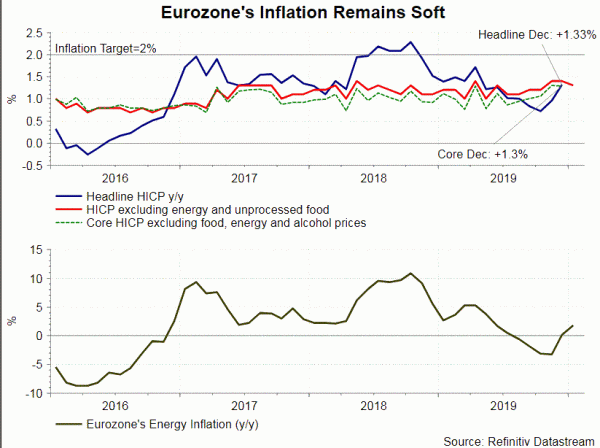
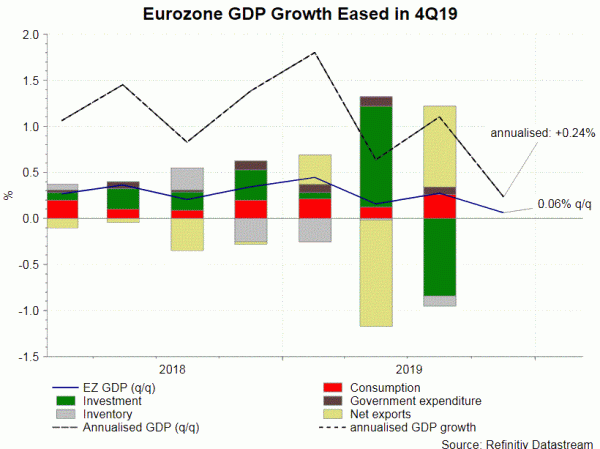 The market now turns the focus to flash PMI and inflation report due later this week. For the former, the composite reading is expected to have eased -0.3 point to 51 in February. Inflation should have remained subdued. Headline and core readings probably steadied at +1.4% y/y and +1.3% y/y, respectively, in January. From a month, both reading probably have shown contraction.
The market now turns the focus to flash PMI and inflation report due later this week. For the former, the composite reading is expected to have eased -0.3 point to 51 in February. Inflation should have remained subdued. Headline and core readings probably steadied at +1.4% y/y and +1.3% y/y, respectively, in January. From a month, both reading probably have shown contraction.
ECB monetary policy: In January, ECB left the deposit rate unchanged at -0.5%. Meanwhile, the main refi rate and marginal lending rate also stay unchanged at 0% and 0.25%, respectively. The pace of the asset purchase program, effective on November 1, also stays at 20B euro per month. Disappointing dataflow over the past weeks and abrupt increase global economic uncertainty emanated from the coronavirus outbreak have raised speculations that ECB could cut the deposit rate further into the negative territory later this year.
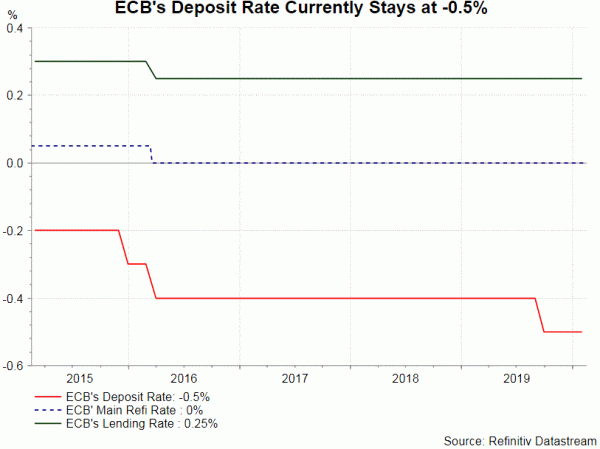 Speaking in the European Parliament’s plenary session on February 11, President Lagarde indicated that the region’s “growth momentum has been slowing down since the start of 2018”. She refrained from using the description “signs of stabilisation” as she did at her European Parliament hearing in the prior week. Board member Philip Lane suggested that the ECB is not near the lower bound on rates as its easing measures continue to be passed through to lower lending rates and continued credit growth. ECB’s meeting minutes, due Thursday is expected to reveal more about the members’ stance on further easing. Meanwhile, declining yield differential between USD and EUR is also facilitating euro’s weakness.
Speaking in the European Parliament’s plenary session on February 11, President Lagarde indicated that the region’s “growth momentum has been slowing down since the start of 2018”. She refrained from using the description “signs of stabilisation” as she did at her European Parliament hearing in the prior week. Board member Philip Lane suggested that the ECB is not near the lower bound on rates as its easing measures continue to be passed through to lower lending rates and continued credit growth. ECB’s meeting minutes, due Thursday is expected to reveal more about the members’ stance on further easing. Meanwhile, declining yield differential between USD and EUR is also facilitating euro’s weakness.
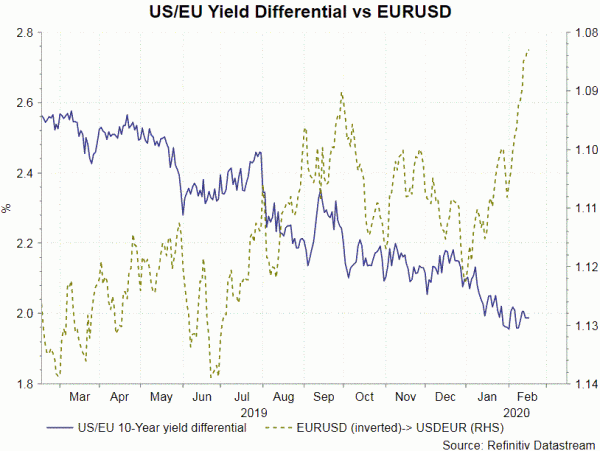 Funding currency: Euro has been a popular funding currency in recent years due to low yield. Besides, it has offered the lowest volatility among other funding currencies. This has made the single currency even more attractive than Japanese yen and Swiss franc as funding currency for carry trade.
Funding currency: Euro has been a popular funding currency in recent years due to low yield. Besides, it has offered the lowest volatility among other funding currencies. This has made the single currency even more attractive than Japanese yen and Swiss franc as funding currency for carry trade.




